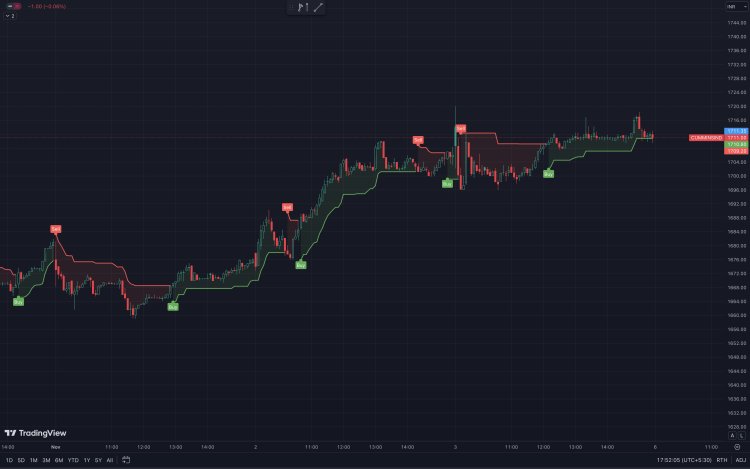Maximizing Profits with Super Trend Indicator: A Comprehensive Guide for Effective Trading in Pine Script 5
Learn how to boost your trading profits using the Super Trend indicator with this comprehensive guide in Pine Script 5. Explore key strategies and insights for effective trend trading. Unlock the full potential of your trading strategy with our comprehensive guide on using the Super Trend indicator in Pine Script 5. Discover essential strategies and insights for optimizing your trading decisions and maximizing profits in trending markets.

Using the Super Trend Indicator for Effective Trading
When it comes to trading in the financial markets, one of the most crucial aspects is identifying the direction of the trend. A trending market can offer numerous opportunities for traders to profit, and that's where the Super Trend indicator comes into play. In this blog post, we'll introduce you to the Super Trend indicator and provide you with a Pine Script code to use it effectively in TradingView.
What is the Super Trend Indicator?
The Super Trend indicator is a popular trend-following tool used by traders to determine the prevailing market trend. It does so by plotting two lines on the chart - an upper line and a lower line. These lines provide insights into potential entry and exit points in the market.
The Super Trend indicator is calculated using the Average True Range (ATR), which measures market volatility, and a multiplier, which can be adjusted based on your trading preferences. Here's a breakdown of the key components of the Super Trend indicator:
-
ATR Length: This parameter determines the length of the ATR calculation, which is used to gauge market volatility.
-
Multiplier: The multiplier is a factor that is applied to the ATR value. It influences the distance between the Super Trend lines and can be adjusted to make the indicator more or less sensitive to price movements.
Using the Super Trend Indicator in TradingView
To use the Super Trend indicator in TradingView, you can easily create a custom script using Pine Script, a domain-specific language for creating custom technical indicators and strategies. Let's go through the steps on how to apply the Super Trend indicator:
Pine Script code for the Super Trend indicator in TradingView:Version 4
//@version=4
study(title="Super Trend", shorttitle="ST", overlay=true)
// Input for Super Trend
length = input(7, title="Super Trend ATR Length")
multiplier = input(3.0, title="Super Trend Multiplier")
// Calculate Average True Range (ATR)
atr_length = sma(tr, length)
atru = rma(tr, length)
// Calculate Super Trend
upperband = hl2 + (multiplier * atru)
lowerband = hl2 - (multiplier * atru)
upTrend = crossover(crossunder(close, lowerband), 0)
downTrend = crossunder(crossover(close, upperband), 0)
// Plot Super Trend
plotshape(series=upTrend, title="Up Trend", location=location.belowbar, color=color.green, style=shape.triangleup, text="Up Trend")
plotshape(series=downTrend, title="Down Trend", location=location.abovebar, color=color.red, style=shape.triangledown, text="Down Trend")
// Fill the area between the Super Trend lines
fill(upperband, lowerband, color=color.blue, transp=70, title="Trend Area")
// Plot the Super Trend lines
plot(upperband, title="Super Trend Upper", color=color.blue)
plot(lowerband, title="Super Trend Lower", color=color.blue)
// Alerts
alertcondition(upTrend, title="Super Trend Up Alert", message="Super Trend is in an Up Trend")
alertcondition(downTrend, title="Super Trend Down Alert", message="Super Trend is in a Down Trend")
Pine Script code for the Super Trend indicator in TradingView:Version 5
//@version=5
indicator(title="Super Trend", shorttitle="ST", overlay=true)
// Input for Super Trend
length = input.int(7, title="Super Trend ATR Length")
multiplier = input.float(3.0, title="Super Trend Multiplier")
// Calculate Average True Range (ATR)
atr_length = ta.sma(ta.tr, length)
atru = ta.rma(ta.tr, length)
// Calculate Super Trend
upperband = ta.hlc3 + (multiplier * atru)
lowerband = ta.hlc3 - (multiplier * atru)
upTrend = ta.crossover(ta.crossunder(close, lowerband), 0)
downTrend = ta.crossunder(ta.crossover(close, upperband), 0)
// Plot Super Trend
plotshape(upTrend, style=shape.triangleup, location=location.belowbar, color=color.green, title="Up Trend")
plotshape(downTrend, style=shape.triangledown, location=location.abovebar, color=color.red, title="Down Trend")
// Fill the area between the Super Trend lines
fill(upperband, lowerband, color=color.blue, title="Trend Area")
// Plot the Super Trend lines
plot(upperband, color=color.blue, title="Super Trend Upper")
plot(lowerband, color=color.blue, title="Super Trend Lower")
// Alerts
alertcondition(upTrend, title="Super Trend Up Alert", message="Super Trend is in an Up Trend")
alertcondition(downTrend, title="Super Trend Down Alert", message="Super Trend is in a Down Trend")
1. Open TradingView and Create a Pine Script
First, log in to your TradingView account and open the Pine Script editor. You can do this by clicking on "Pine Editor" in the bottom panel of the TradingView platform.
2. Copy and Paste the Super Trend Pine Script
Copy the Pine Script code provided earlier in this blog post and paste it into the Pine Script editor in TradingView.
3. Adjust the Parameters
You can customize the Super Trend indicator by modifying the following parameters in the script:
-
length: This determines the length of the ATR calculation. A longer length makes the indicator less sensitive to price movements, while a shorter length makes it more sensitive. -
multiplier: The multiplier influences the distance between the Super Trend lines. A higher multiplier makes the lines wider apart, and a lower multiplier brings them closer together.
4. Apply the Indicator to Your Chart
Once you've pasted the script and made any desired parameter adjustments, click the "Add to Chart" button to apply the Super Trend indicator to your price chart.
5. Interpret the Super Trend Signals
The Super Trend indicator will plot two lines on your chart - an upper band and a lower band. Here's how to interpret the signals:
-
Up Trend: A green triangle above the price bars signals an uptrend. This suggests that you should consider buying or holding long positions.
-
Down Trend: A red triangle below the price bars indicates a downtrend. This is a signal to consider selling or holding short positions.
-
Trend Area: The area between the upper and lower bands is filled with a blue color. This region helps you visualize the strength of the current trend. A wider area indicates a strong trend, while a narrower area suggests a weaker trend.
6. Set Up Alerts
The script also allows you to set up alerts for Super Trend signals. You can configure alerts for both up and down trends. This way, you can receive notifications when the indicator detects a potential trend change.
Conclusion
The Super Trend indicator is a valuable tool for traders looking to identify and follow market trends. By using the provided Pine Script code in TradingView, you can easily incorporate this indicator into your trading strategy. Remember to adjust the ATR length and multiplier to suit your trading style and preferences.
As with any trading indicator, it's essential to use the Super Trend in conjunction with other technical analysis tools and risk management strategies. By doing so, you can make more informed trading decisions and potentially improve your trading results.
Happy trading, and may the Super Trend indicator guide you towards profitable opportunities in the financial markets!
Disclaimer: The information provided in this blog post, "Maximizing Profits with Super Trend Indicator: A Comprehensive Guide for Effective Trading in Pine Script 5," is for educational and informational purposes only. Trading in financial markets involves risk, and it's essential to conduct your research and exercise caution when making trading decisions. The use of the Super Trend indicator or any other trading tools should not be considered as financial advice. The author and the platform do not guarantee the accuracy or completeness of the information presented, and they are not responsible for any trading losses or decisions made based on this content. You should consult with a qualified financial professional and consider your own financial situation, risk tolerance, and trading objectives before implementing any strategies discussed in this blog post.
What's Your Reaction?



















